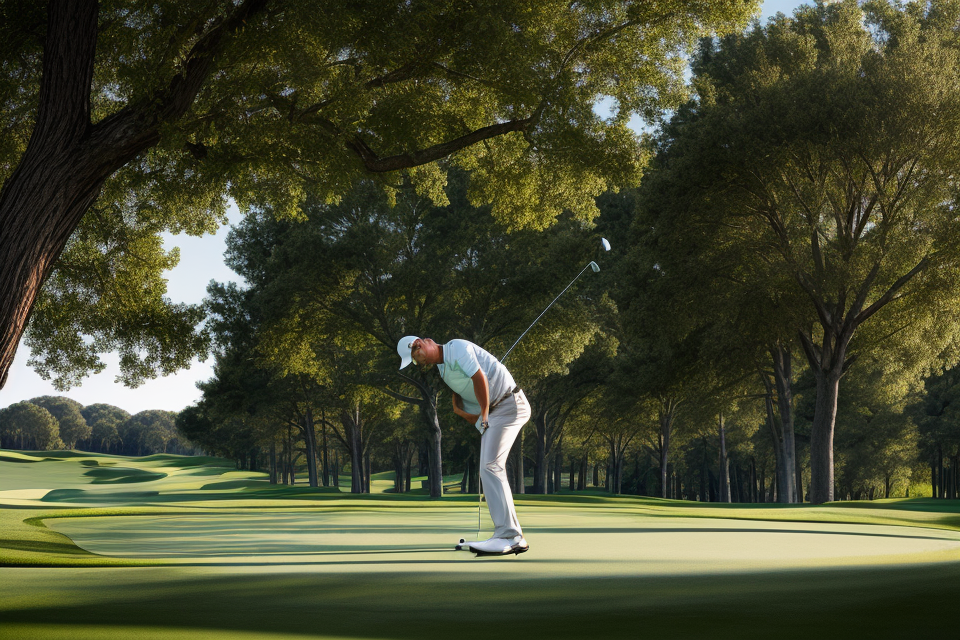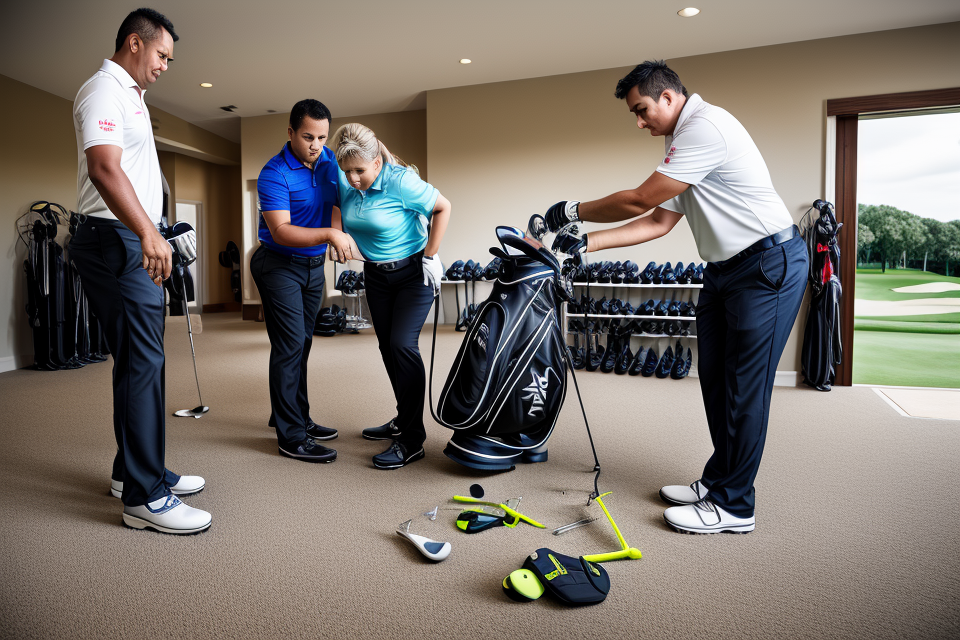
Golf is a game of precision and accuracy, and one of the most crucial aspects of the game is the loft adjustment on a golf club. It refers to the angle of the clubface that affects the trajectory and distance of the shot. The loft adjustment is a key factor that determines how the ball will behave after it’s hit, and it’s essential to understand how it works to improve your game. In this article, we’ll delve into the world of loft adjustment, exploring what it is, how it affects your shots, and how to adjust it to your advantage. Whether you’re a seasoned pro or a beginner, this guide will help you take your game to the next level. So, get ready to discover the secrets of loft adjustment and how it can transform your golf game!
Loft adjustment on a golf club refers to the ability to change the angle of attack of the clubface during the swing, which can affect the trajectory and spin of the ball. Adjusting the loft can help golfers optimize their shot selection, especially in changing conditions or when trying to hit specific shots. Higher loft angles can result in shorter, higher-trajectory shots, while lower loft angles can produce longer, lower-trajectory shots. However, too much loft adjustment can also lead to loss of control, and golfers need to find the right balance to suit their playing style and the conditions they face on the course.
Understanding Loft Adjustment on a Golf Club
The Basics of Loft in Golf Clubs
Loft refers to the angle between the shaft of a golf club and the ground, which affects the trajectory and distance of a golf shot. The loft of a golf club is measured in degrees, and it varies depending on the type of club. For example, a driver typically has a lower loft angle compared to a sand wedge, which has a higher loft angle.
The loft angle of a golf club affects the trajectory of the ball. A higher loft angle will result in a higher, more controlled trajectory, while a lower loft angle will result in a lower, more powerful trajectory. Additionally, the loft angle of a golf club also affects the distance of the shot. A higher loft angle will result in a shorter distance, while a lower loft angle will result in a longer distance.
When comparing different loft angles in golf clubs, it’s important to consider the type of shot you want to make. For example, a driver with a lower loft angle is ideal for hitting long, straight shots, while a sand wedge with a higher loft angle is ideal for making short, high-lofted shots around the green.
Understanding the basics of loft in golf clubs is crucial for golfers to choose the right club for the shot they want to make, and to adjust their swing accordingly to achieve the desired trajectory and distance.
How Loft Adjustment Works
Loft adjustment refers to the process of altering the angle of attack of a golf club, which can affect the trajectory and distance of a shot. This process is commonly used by professional golfers to fine-tune their shots and optimize their performance on the course.
There are different methods of loft adjustment on golf clubs, including:
- Adjustable loft: Some golf clubs have adjustable loft mechanisms that allow the golfer to adjust the angle of attack of the clubface. This is typically done by twisting or turning a knob or screw on the shaft or clubhead.
- Shaft insert: Some golf clubs have a shaft insert that can be removed or replaced to alter the loft angle of the club. This method is often used by golfers who want to change the loft of their driver or fairway woods.
- Replacement clubhead: In some cases, golfers may choose to replace their existing clubhead with one that has a different loft angle. This can be done by purchasing a new clubhead or having one custom-made to suit their needs.
Understanding how loft adjustment works can help golfers to make informed decisions about their equipment and optimize their performance on the course. By adjusting the loft angle of their clubs, golfers can fine-tune their shots and achieve the desired trajectory and distance, which can lead to improved accuracy and better overall performance.
The Effects of Loft Adjustment on Ball Flight
When a golfer adjusts the loft angle of their golf club, they are altering the trajectory and distance of their shots. The loft angle is the angle between the clubface and the ground when the club is in a standard address position. Changing the loft angle affects the ball’s flight by determining the trajectory, spin rate, and overall distance of the shot.
In general, a higher loft angle results in a higher trajectory and less distance, while a lower loft angle results in a lower trajectory and more distance. However, the specific effects of loft adjustment on ball flight can vary depending on the golfer’s swing, ball speed, and other factors.
Comparing Different Ball Flights with Varying Loft Angles
- Lower loft angle (e.g., driver):
- Lower trajectory
- Longer distance
- Less spin rate
- Higher loft angle (e.g., sand wedge):
- Higher trajectory
- Shorter distance
- Higher spin rate
It is important for golfers to understand the effects of loft adjustment on ball flight in order to select the appropriate club for each shot and to adjust their swing accordingly. By choosing the right club and adjusting their swing to account for the loft angle, golfers can optimize their ball flight and achieve the desired result on the course.
Factors Affecting Loft Adjustment
Loft adjustment on a golf club refers to the ability to adjust the angle of the clubface in relation to the golf ball. The angle of the clubface has a significant impact on the trajectory and distance of the shot. The loft adjustment feature is typically found on drivers, fairway woods, and hybrids. In this section, we will discuss the factors that can affect loft adjustment on a golf club.
Golf Club Condition
The condition of the golf club can have a significant impact on the loft adjustment. For example, if the golf club is worn or damaged, it may not function properly, resulting in an incorrect loft adjustment. It is important to regularly check the condition of your golf clubs and have them serviced if necessary.
Swing Speed
The speed of your swing can also affect the loft adjustment. If you swing the golf club too slowly, the ball may not be hit with enough force to reach the desired distance. On the other hand, if you swing too quickly, the ball may be hit too high, resulting in a lower distance. Finding the right balance between swing speed and loft adjustment is essential for optimizing your game.
Ball Position
The position of the golf ball on the tee or fairway can also impact the loft adjustment. If the ball is positioned too far forward or too far back in the stance, it can affect the angle of the clubface and the trajectory of the shot. It is important to position the ball correctly to ensure the best possible loft adjustment.
Turf Conditions
The condition of the turf can also have an impact on the loft adjustment. For example, if the turf is soft or wet, it may affect the trajectory of the shot, resulting in a lower distance. It is important to take into account the turf conditions when adjusting the loft on your golf club.
In conclusion, the factors that can affect loft adjustment on a golf club include the condition of the golf club, swing speed, ball position, and turf conditions. By understanding these factors, you can optimize your loft adjustment and improve your game.
Benefits of Loft Adjustment
Loft adjustment refers to the ability to adjust the angle of the golf club’s face, which can affect the ball’s trajectory and distance. The primary benefit of loft adjustment is improved ball control and accuracy. Here are some of the specific advantages of adjusting the loft on a golf club:
- Improved accuracy: By adjusting the loft on a golf club, golfers can control the ball’s trajectory more effectively, leading to improved accuracy. This is particularly useful for approach shots, where precision is key.
- Increased distance: Adjusting the loft on a golf club can also increase distance, particularly for longer shots. This is because the ball will travel higher and farther with a higher loft angle, resulting in more distance.
- Customization: Loft adjustment allows golfers to customize their clubs to their personal swing and playing style. This can lead to better performance and increased satisfaction with their equipment.
- Versatility: Loft adjustment allows golfers to use the same club for a variety of shots, rather than having to switch between clubs with different loft angles. This can save time and simplify the golf bag.
Overall, the benefits of loft adjustment on a golf club are significant and can lead to improved performance and satisfaction for golfers of all skill levels.
Choosing the Right Loft Adjustment for Your Game
Factors to Consider
When it comes to choosing the right loft adjustment for your golf clubs, there are several factors to consider. Understanding these factors can help you make an informed decision that will improve your game.
- Swing Speed
One of the most important factors to consider is your swing speed. If you have a slower swing speed, you may want to choose a higher loft angle to help you get the ball in the air. Conversely, if you have a faster swing speed, you may want to choose a lower loft angle to help you get more distance. - Ball Flight
Another important factor to consider is your ball flight. If you tend to hit the ball high and short, you may want to choose a higher loft angle to help you get more height and distance. If you tend to hit the ball low and long, you may want to choose a lower loft angle to help you get more control. - Course Conditions
The course conditions can also play a role in choosing the right loft adjustment. For example, if you are playing on a windy day, you may want to choose a higher loft angle to help you control the ball. If you are playing on a course with tight fairways, you may want to choose a lower loft angle to help you get more distance. - Personal Preference
Finally, your personal preference is also an important factor to consider. Some golfers prefer a higher loft angle because it helps them hit the ball higher and straighter. Others prefer a lower loft angle because it helps them get more distance. Ultimately, the right loft adjustment for you will depend on your individual preferences and playing style.
By considering these factors, you can make an informed decision about the right loft adjustment for your golf clubs. Experimenting with different loft angles can also help you find the best fit for your game.
Common Loft Adjustments for Different Golfers
Loft adjustment on a golf club refers to the angle between the clubface and the shaft when the club is in a set position. The loft adjustment affects the trajectory and distance of the golf ball, making it an essential aspect of the game.
There are different loft adjustments available for golfers, and each has its own benefits. Understanding the common loft adjustments for different golfers can help you choose the right one for your game.
Overview of Common Loft Adjustments for Different Types of Golfers
The following are some of the common loft adjustments for different types of golfers:
- High loft: High lofts are suitable for golfers who have a slower swing speed or have trouble getting the ball airborne. The high loft angle helps the ball to lift off the ground and travel a shorter distance, making it easier to control.
- Standard loft: Standard lofts are ideal for most golfers with a moderate swing speed. This loft angle provides a balance between distance and control, allowing the golfer to hit the ball with enough power to reach the green while still having some roll after landing.
- Low loft: Low lofts are suitable for golfers with a fast swing speed or who want to hit the ball further. The low loft angle provides less air resistance, resulting in more distance and a lower trajectory.
Explanation of How Different Loft Adjustments Can Benefit Different Golfers
The loft adjustment on a golf club can benefit different golfers in different ways. For instance, a golfer with a slow swing speed can benefit from a high loft angle, which helps them lift the ball off the ground and control their shots. On the other hand, a golfer with a fast swing speed can benefit from a low loft angle, which provides more distance and a lower trajectory.
Choosing the right loft adjustment for your game depends on your swing speed, ball trajectory, and playing style. Experimenting with different loft angles can help you find the one that works best for you and improve your overall game.
Making Changes to Your Golf Clubs
Explanation of the Process of Making Changes to Your Golf Clubs
To make changes to your golf clubs, you will need to remove the clubhead and shaft from the grip end. This can typically be done by unscrewing the grip or using a special tool designed for this purpose. Once the clubhead and shaft are removed, you can adjust the loft by making small modifications to the angle of the clubhead or by using a different shaft with a different degree of bend.
Tips for Ensuring Proper Adjustment and Maintaining Golf Club Performance
- Use a torque wrench to ensure that the adjustments are made properly and that the clubhead and shaft are securely attached.
- Check the loft angle of your club after making any adjustments to ensure that it is within the appropriate range for your game.
- Keep your golf clubs in good condition by regularly cleaning and maintaining them, and by having them checked by a professional if you notice any changes in performance.
- Make sure to only make adjustments to your golf clubs when necessary, as frequent changes can negatively impact the performance of your clubs.
FAQs
1. What is loft adjustment on a golf club?
Loft adjustment on a golf club refers to the ability to adjust the angle of the clubface in relation to the shaft. This feature is designed to help golfers optimize their shot-making by adjusting the loft of the club to suit their individual swing and ball flight preferences.
2. How does loft adjustment affect your game?
Loft adjustment can have a significant impact on your game by allowing you to control the trajectory and spin of your shots. By adjusting the loft of your club, you can change the height and distance of your shots, as well as the amount of spin that is imparted on the ball. This can help you to achieve a variety of different shots, from high, soft approaches to low, piercing drives.
3. How do you adjust the loft on a golf club?
The process for adjusting the loft on a golf club will vary depending on the specific club and the type of adjustment system it uses. Some clubs may have a simple adjustment mechanism that allows you to change the loft by rotating a knob or pulling a lever. Other clubs may use a more sophisticated system that involves moving weight pads or adjusting the angle of the hosel. It’s important to read the manufacturer’s instructions carefully and practice adjusting the loft until you become familiar with the process.
4. Can loft adjustment affect the overall performance of your golf club?
Yes, loft adjustment can have an impact on the overall performance of your golf club. Changing the loft can affect the ball’s trajectory, spin, and roll, which can in turn affect the club’s overall performance. It’s important to experiment with different loft settings to find the one that works best for your swing and playing style.
5. Are there any downsides to using a golf club with loft adjustment?
One potential downside to using a golf club with loft adjustment is that it can be more difficult to get used to than a fixed-loft club. It may take some time and practice to become comfortable with adjusting the loft and to learn how to optimize your shot-making with the different loft settings. Additionally, some golfers may find that adjusting the loft on their clubs is distracting or takes away from the traditional feel of playing with a golf club.


